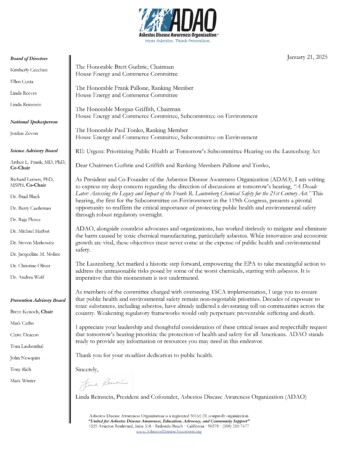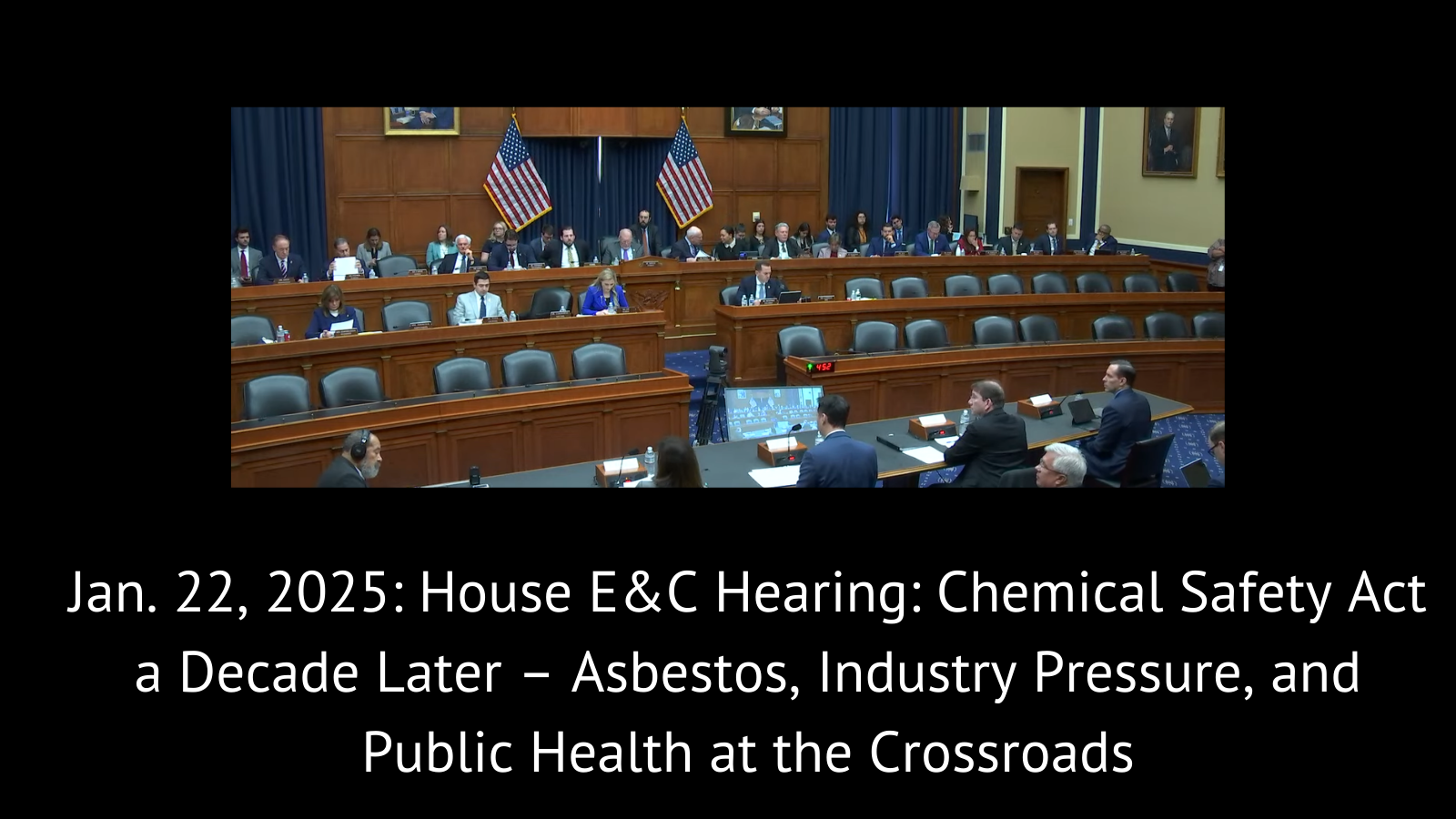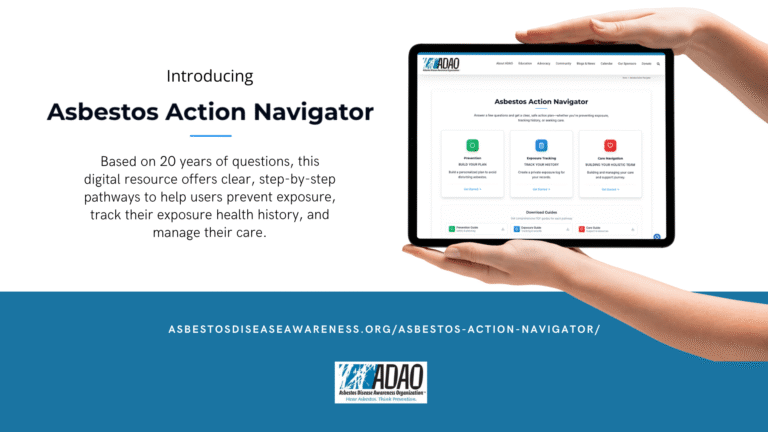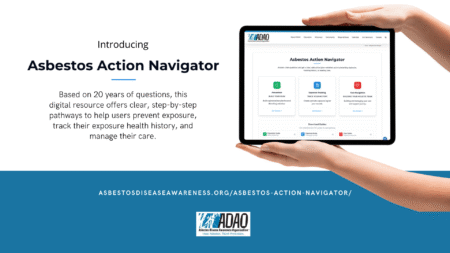Posted on January 23, 2025
Yesterday’s hearing, “A Decade Later: Assessing the Legacy and Impact of the Frank R. Lautenberg Chemical Safety for the 21st Century Act,” provided an opportunity to reflect on the progress and shortcomings of this landmark legislation. Asbestos, once the poster child for TSCA reform, remains legal in the US today, and it continues to devastate communities. Asbestos claims over 40,000 American lives annually, yet asbestos-caused illnesses are entirely preventable. This failure to fully regulate asbestos underscores the urgent need for bold legislative action to protect public health. 
Witness testimonies revealed the significance of the persistent tension between public safety and industry innovation, raising critical questions about the balance between these competing priorities.
A Call for Public Health Prioritization
In a letter addressed to the Subcommittee on Environment before the hearing, I emphasized that this session presented a critical opportunity to reaffirm the importance of protecting public health and environmental safety through robust regulatory oversight. The Lautenberg Act, signed into law in 2016, marked a historic step forward by empowering the Environmental Protection Agency (EPA) to address the unreasonable risks posed by dangerous chemicals, starting with asbestos. However, progress on asbestos has stalled, jeopardizing the health and safety of countless Americans.
As I wrote in my letter, “Decades of exposure to toxic substances, including asbestos, have already inflicted a devastating toll on communities across the country. Weakening regulatory frameworks would only perpetuate preventable suffering and death.”
The Asbestos Disease Awareness Organization (ADAO) has tirelessly advocated for policies to eliminate the harm caused by toxic chemical manufacturing, particularly asbestos. While innovation and economic growth are important, these objectives must never come at the expense of public health or environmental safety.
Key Challenges in Chemical Safety Regulation: A Public Health Perspective
The recent Subcommittee hearing highlighted critical shortcomings in the implementation of the Lautenberg Act, with clear calls to strengthen public health protections and hold the EPA accountable to its mission of safeguarding communities:
- EPA’s Resource Challenges: Due to insufficient resources, the EPA has struggled to meet mandatory deadlines for chemical reviews. As I noted in my letter, these delays threaten to undermine the momentum TSCA reform intended to create. Strengthening the EPA’s funding and capacity is critical to fulfilling the promise of the Lautenberg Act.
- Legacy Chemicals Like Asbestos: Despite its well-documented dangers, asbestos remains dangerously underregulated, even after being designated a priority under TSCA. As I stressed in my letter: “Decades of inaction on asbestos have already inflicted immense suffering and death. Addressing this legacy chemical must remain a top priority.”
- Industry’s Role in Delays: Industry representatives raised concerns about regulatory inefficiencies; however, public health advocates highlighted that delays often stem from incomplete data submissions by manufacturers. Holding the industry accountable for providing timely and comprehensive information is vital to ensuring science-based decision-making that prioritizes safety.
Witness Testimony Reflects Ongoing Tensions
The witness list for yesterday’s hearing underscored the divide between industry perspectives and public health advocacy:
- Chris Jahn, President & CEO, American Chemistry Council
- Witness Testimony
- Geoff Moody, Senior VP, American Fuel and Petrochemical Manufacturers
- Witness Testimony
- Dr. Richard Engler, Director of Chemistry, The Acta Group
- Witness Testimony
- Dr. Maria Doa, Senior Director, Environmental Defense Fund
- Witness Testimony
Their testimonies illuminated the challenges of balancing public health protections with industry innovation, reinforcing the need for bold legislative action.
Gratitude for Congressional Leadership
On behalf of the Asbestos Disease Awareness Organization (ADAO), I extend my deepest gratitude to Ranking Members Paul Tonko and Frank Pallone for their unwavering leadership in prioritizing public health. Their commitment to environmental safety and chemical reform remains an inspiration and exemplifies the bipartisan action needed to tackle these critical challenges.
The Path Forward
While the Lautenberg Act was a significant achievement, its full potential remains unfulfilled. Legacy chemicals like asbestos continue to harm communities and cause painful, unnecessary deaths, while delays in implementation erode public trust. To address these ongoing challenges, Congress must:
- Strengthen the EPA’s authority and resources.
- Pass the Alan Reinstein Ban Asbestos Now (ARBAN) Act to permanently eliminate asbestos.
- Hold industry accountable for providing complete and accurate data to enable timely and effective regulatory action.
As I emphasized in my letter, “This hearing presents a pivotal opportunity to ensure that public health and environmental safety remain non-negotiable priorities.”
ADAO is committed to providing data, resources, and testimony to support policies that protect public health and create a future free from preventable toxic exposures. To learn more, visit www.asbestosdiseaseawareness.org.
Linda Reinstein



